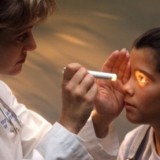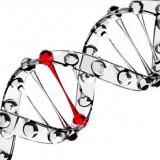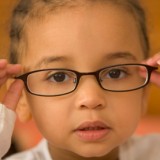Recognizing Kids’ Eye Problems
It is estimated by the American Optometric Association that approximately 25 percent of school age children have vision problems. A recent study found that over 11 percent of surveyed teenagers had eye problems that had gone undetected and untreated. Recognizing kids’ eye problems is key to preventing this lack of detection and providing needed treatment. Kids’ Eye Problem Warning Signs Any children with a family history of vision problems or eye conditions should be screened regularly, beginning with the first well baby exam. Parents can also help to spot eye conditions in kids by watching for signs of vision problems. Eye problems may manifest different signs at different ages. Under One Year Old Children under one year of age but over three months of age should be able to make eye contact and track objects by moving the eyes. Failure to regularly exhibit these behaviors may be a sign of eye problems or other complications. After four months of age, kids’ eyes should also begin to stay more focused and stop drifting inward or outward. Preschool Age By preschool age, if a child’s eyes become misaligned, parents should request a medical examination by a doctor. Parents should also be vigilant for signs of eye problems, such as failure to identify objects or faces at a distance. Some eye problems may not have visible signs, so parents should also request an eye examination to test vision. Even if children cannot read, there are special eye examination charts that can be used. Grade School Age In grade school, children’s eye problems may be recognizable by learning complications and poor grades. If there are vision problems, the child may not be able to see the blackboard or other teaching tools that the teacher uses. If there are other eye conditions, pain or irritation may distract the child from learning. Children often do not understand what is normal and what is a symptom of a condition, so it is up to parents and teachers to recognize signs of eye problems. Other signs that children may have eye problems include: White or red color in pupil, especially in photographs Misalignment or drifting of one or both eyes Eye pain Eye itchiness Drooping eyelids or frequent squinting Sensitivity to light Crust in the eye Bulges in or around the eye “Bouncing” eyes that move quickly up and down or side to side Delayed Detection of Eye Problems Eye problems that go undetected can have many negative consequences on a child’s life. Vision problems can affect the child’s ability to learn and see clearly. This can affect the child’s perception and self esteem, and may limit the child in many ways. Certain eye conditions such as pediatric retinoblastoma can also impact a child’s health and cause fatality if not treated quickly. Sources: “Eye Health Statistics at a Glance.” American Academy of Ophthalmology. American Academy of Ophthalmology, 1 Apr. 2011. Web. 16 Sept. 2014. <http://www.aao.org/newsroom/upload/Eye-Health-Statistics-April-2011.pdf> Salvin, Jonathan. “Amblyopia.” KidsHealth – the Web’s Most Visited Site about Children’s Health. The Nemours Foundation, 1 Sept. 2011. Web. 16 Sept. 2014. <http://kidshealth.org/parent/general/eyes/amblyopia.html> “The Need for Comprehensive Vision Examination of Preschool and School-age Children.” American Optometric Association. American Optometric Association, 1 Jan. 2014. Web. 16 Sept. 2014. <http://www.aoa.org/optometrists/education-and-training/clinical-care/the-need-for-comprehensive-vision-examination-of-preschool-and-school-age-children?sso=y> “Warning Signs of Vision Problems in Children.” HealthyChildren.org. American Academy of Pediatrics, 1 July 2013. Web. 16 Sept. 2014....
read moreRetinoblastoma Family Caregivers
Retinoblastoma is a type of cancer that affects the retina of the eye, typically in children under the age of five. For families that have had a child diagnosed with retinoblastoma, child care can become difficult. Family caregivers of retinoblastoma patients are often emotional about the diagnosis and treatment. Decisions such as which foods to feed the child and how to assist with aspects of development often take on increased significance and add uncertainty to daily care. Family Caregivers Support Programs Many hospitals offer group support programs for families of children that have been diagnosed with pediatric retinoblastoma and other cancers. These support programs can supply helpful information about daily care for retinoblastoma patients, and can introduce family caregivers to others in the area that are enduring similar situations. Support programs often offer an emotional respite for family caregivers and can be more helpful than other types of individual therapy or counseling. Support programs are also available online for families that are traveling to the administering hospital or that do not wish to take part in the hospital’s programs. Retinoblastoma Physician Advice The physicians that treat retinoblastoma patients are typically knowledgeable about the specific patient’s condition and will be able to provide more helpful advice concerning care than generic sources. Physicians may also be able to recommend programs that aid in childhood development or specialists that will be able to help with certain aspects of care. Family caregivers should inquire about daily care needs when speaking to physicians regarding retinoblastoma treatment and diagnosis. Caregiver Emotional Counseling It may be helpful for family caregivers to seek individual emotional counseling in addition to group support. Family caregivers may face emotional burdens regarding the pediatric retinoblastoma diagnosis, concerns about daily care, and other aspects of caring for a child with special needs. Family caregivers may also suffer from feelings of guilt for taking care of personal needs or other complex emotions. Emotional counseling may allow family caregivers to vent frustrations and overcome emotional difficulties. Family Caregiver Assistance Family caregivers may be able to find programs in the area that provide assistance with daily care for retinoblastoma patients, sometimes at a reduced cost. One of the major difficulties that family caregivers face is burnout and an inability to find time for self-care. Assistance programs may be able to provide valuable respite for overwhelmed family caregivers. Professional caregivers may also provide helpful advice for daily care of children that have been diagnosed with retinoblastoma. Sources: http://www.dana-farber.org/Pediatric-Care/Treatment-and-Support/Retinoblastoma.aspx http://www.mdanderson.org/patient-and-cancer-information/cancer-information/cancer-types/retinoblastoma/education-resources/index.html...
read morePediatric Retinoblastoma Relapse
Pediatric retinoblastoma is the most common type of eye tumor that develops in children. Pediatric retinoblastoma has a high rate of curability, with about 95 percent of patients being cured of the disease and roughly 90 percent retaining vision in at least one eye. However, the genetic nature of the disease increases the probability of relapse and the formation of secondary tumors. Retinoblastoma Relapse Cause In hereditary retinoblastoma, patients often have the genetic mutation that causes retinoblastoma in the RB1 gene in all cells of the body. Besides the egg and sperm cells, all cells of the body ordinarily have two RB1 genes. In patients with the genetic mutation, any change in the remaining RB1 gene in any body cell can cause a retinoblastoma tumor to develop in that cell. Patients with non-hereditary retinoblastoma are not as susceptible to relapse. Hereditary Retinoblastoma In only about 10 to 20 percent of cases of hereditary retinoblastoma does a child inherit the mutated RB1 gene from a parent with the same genetic mutation. In most cases, the RB1 mutation is a result of an abnormality in an RB1 gene in the father’s sperm or the mother’s egg. While the child will be the first in the family to have retinoblastoma, it is considered hereditary retinoblastoma. In rare cases, parents may carry the RB1 mutation in some body cells but not others, allowing the mutation to be passed on but not causing tumors to form in the parent. Patients that have hereditary retinoblastoma have a 50 percent chance of passing the disease on to children. Additional Tumor Development In addition to the increased likelihood of retinoblastoma relapse, patients that have hereditary retinoblastoma are also much more likely to develop additional tumors. Tumors may develop anywhere in the body, most commonly in the bones or muscles. The risk of developing additional tumors is increased by the use of radiation therapy, so this type of treatment should be avoided in patients with hereditary retinoblastoma. Preventing Retinoblastoma Relapse Patients that have undergone successful treatment for hereditary pediatric retinoblastoma should be frequently screened for cancers of all kinds. Since pediatric retinoblastoma typically affects children under the age of five, this means lifetime monitoring. Patients should always make physicians aware of the retinoblastoma history and the increased risk for cancer development. Healthy Lifestyle A healthy lifestyle can also help to prevent pediatric retinoblastoma relapse. Behaviors such as smoking, drinking alcohol, and eating an unbalanced diet may greatly increase the chances of tumor development I those that have the RB1 mutation. Patients should also be alert for any abnormalities or pains that may be an indication of retinoblastoma relapse or additional tumor development. Sources: http://www.dana-farber.org/Health-Library/Childhood-Retinoblastoma.aspx http://www.hopkinsmedicine.org/kimmel_cancer_center/centers/pediatric_oncology/cancer_types/retinoblastoma.htm...
read moreCommon Hereditary Eye Diseases
Many common diseases affecting vision can be passed on through genes. Approximately 60 percent of infant blindness is caused by inherited eye diseases. Some eye conditions may also manifest later in life, causing blindness or vision complications. Types of Hereditary Eye Diseases Hereditary eye conditions may vary widely in the way that patients’ vision, eyes, and health are affected. Some diseases may simply require simple treatments, while others may be life threatening and require surgeries. There may or may not be pain, depending on the condition and the severity. Glaucoma Glaucoma is one of the main causes of blindness in the United States. In patients with glaucoma, the fluid inside of the eye does not drain properly. This puts pressure on the eye, and can damage the fundamental structure of the eye. Glaucoma can cause pain and eventual blindness, especially if left untreated. Glaucoma can be acute or chronic, and may show no symptoms. Color Blindness About eight percent of males suffer from color blindness, whereas only about .5 percent of females suffer from the condition. The exact cause of color blindness is unknown, but the condition typically causes an inability to distinguish between certain colors. Color blindness does not cause other complications, but may inhibit a patient’s ability to perform certain jobs or tasks. There is currently no treatment for color blindness, although research efforts have shown effectiveness with animals in a lab setting. Nystagmus Involuntary, erratic movements of the eye characterize the condition known as nystagmus. The erratic movements may cause vision complications due to the patient’s inability to focus in one place, and may also cause the patient to suffer from nausea and dizziness. At this time, there is no effective treatment for nystagmus, but patients often learn to live with the disorder and minimize the visual impairment by moving the head in certain ways. Albinism Albinism causes patients to be born with less pigmentation in certain areas of the body, and the eyes are often affected. The retina may be improperly developed, and the iris is often white or pinkish, inhibiting the ability to properly block light from the pupil. Nystagmus is often a secondary complication in albinism. Lenses may be worn to help block out light, but other aspects of the disease have not been effectively treated at this time. Macular Degeneration Degeneration of the macula can be sudden or gradual. The macula is the part of the retina that helps form the center of images that are seen, so peripheral vision may not be affected in some cases. Macular degeneration can cause eventual blindness. In some cases, surgery may help to reverse the effects of the disease. Retinoblastoma Retinoblastoma is a type of cancer that develops in the retina in children. Retinoblastoma is life-threatening. Treatment for retinoblastoma may include surgery to remove all or a portion of the eyes, chemotherapy, and radiation therapy. Blindness may result from either the disease or the treatment. Early Diagnosis of Eye Diseases It is important for patients to inform physicians of any family history of eye diseases in order to aid early detection. In some cases, genetic testing or certain screening methods may help to catch diseases in early stages before symptoms are present. Early treatment may help to prevent diseases from developing or progressing. While not all hereditary eye diseases can be prevented, knowing that there is a high risk of developing certain conditions can help patients to avoid behaviors that may be conducive to the development of the diseases and can allow physicians to take steps to prevent the disease or mitigate its effects. ...
read more3 Kids’ Eye Health Myths
There are several myths about kids’ eye health that have been passed down over the years and are often believed by parents. These myths can sometimes prevent parents from recognizing real problems or can delay proper treatment methods. It is important for parents to research and separate the fact from fiction when it comes to kids’ eye health. Common Eye Myths Some of the most common myths about kids’ eye health are that kids can develop eye problems from sitting too close to the television, wearing contacts is dangerous for kids, and that eating a lot of carrots will help to improve eyesight. These myths have been disproven by scientific research, but still continue to surface. Myth 1 – Sitting Too Close to Television Can Damage Eyesight Many children sit close to the television screen because children’s eyes are often able to focus on close objects more easily than adults. However, sitting very close may be a warning sign that a child is nearsighted and is having problems seeing the television screen. The myth that sitting too close could damage eyesight began in the 1960s, when televisions emitted harmful rays. Televisions have since been modified and no longer emit rays that may damage eyesight. Staring at a screen for long periods of time may cause eye strain and blurred vision, though, so kids should take frequent breaks from the television to reduce the likelihood of these issues. Myth 2 – Contact Lenses Are Dangerous for Kids Contact lenses can be helpful in situations where the child has very different prescriptions for each eye, has undergone surgery, or has suffered from certain diseases. If a child under the age of ten will be using contact lenses, a parent should be assisting with inserting, removing, and cleaning the lenses. This myth may have been started because children can damage their eyes if contacts are removed or inserted without assistance. Contact lenses for kids should only be obtained with a prescription, and should only be used after talking to a doctor. Myth 3 – Eating Carrots Can Improve Eyesight Carrots contain vitamin A, which is a vitamin that is necessary to good health. However, eating carrots has not seemed to improve the eyesight in studies, nor does research support this claim. A deficiency of vitamin A may cause nighttime blindness, so eating carrots may help to prevent or treat this condition. This may be the truth behind the myth that frequently eating carrots will improve eyesight. Good Practices for Kids’ Eye Health It is important for parents to understand practices that will promote healthy vision in children, and ignore the myths. Sunlight can damage eyesight, so children should wear sunglasses, especially at times of the day and year when the sun is strongest. Children should also wear protective goggles or glasses when participating in activities that may damage the eyes. Last but not least, children should be taken in for regular check-ups with an eye doctor to monitor eye and vision development and spot potential problems. Sources: http://www.geteyesmart.org/eyesmart/living/five-vision-myths.cfm http://kidshealth.org/parent/general/eyes/vision_facts_myths.html http://www.chla.org/site/c.ipINKTOAJsG/b.6064403/k.AE93/Eye_Health_Myths_and_Facts__Kids_Eye_Health__The_Vision_Center.htm#.U6nFD0AfMdV...
read moreKids’ Astigmatism
Just as in adults, astigmatism can also affect children. A study by the National Institutes of Health found that roughly 10 percent of children have astigmatism. Kids’ astigmatism is often congenital, or present at birth. However, astigmatism may also occur after an eye injury or operation. Astigmatism is typically easier to identify in adults, as they are more capable of accurately discussing and expressing symptoms. It is important to be aware of kids’ astigmatism symptoms so that children can receive prompt treatment. What Is Astigmatism? Astigmatism is a type of refractive error that occurs when the surface of the eye is irregularly shaped. The primary side effect of astigmatism is blurred and distorted vision. Blurred vision occurs because the light entering the eye cannot be focused correctly onto the retina due to the improperly shaped eye. Astigmatism is not contagious, and is a fairly common condition. Types of Astigmatism There are two types of astigmatism: corneal astigmatism and lenticular astigmatism. As indicated by the name, corneal astigmatism occurs when the cornea is irregularly shaped. Lenticular astigmatism occurs when the lens of the eye is irregularly shaped. Irregularities in shape typically occur as one half of the cornea or lens being flatter or steeper than the other side. Kids’ Astigmatism Symptoms Astigmatism may be particularly difficult to detect in children. Parents, teachers, and other adults should be aware of the symptoms of kids’ astigmatism so that the condition can be diagnosed as soon as possible. Failure to diagnose kids’ astigmatism can lead to more severe vision and overall health issues as the child ages. The following symptoms may indicate the presence of kids’ astigmatism: Photophobia, or sensitivity to light Distorted or blurred vision at any distance Excessive eye straining in order to see Headaches and dizziness due to poorer vision Frequent closing of the eyes Excessive squinting in an attempt to see better Kids’ Astigmatism Treatment In most cases, kids’ astigmatism can be treated with eyeglasses or contact lenses, depending on the age and condition of the patient. Optometrists may prefer to prescribe contact lenses to kids who experience headaches, eye strain, and vision distortion due to frequent head tilting to see clearly. Astigmatism Surgery Eye surgery may be needed to treat severe cases. Kids’ astigmatism eye surgery includes LASIK (laser-assisted in situ keratomileusis) surgery and PK surgery (photorefractive keratectomy). LASIK surgery uses a laser beam to remove part of the corneal tissue, thus reshaping the cornea. PK surgery also reshapes the cornea, but without the use of a laser. Sources: http://www.nei.nih.gov/news/statements/pediatric.asp...
read more





















